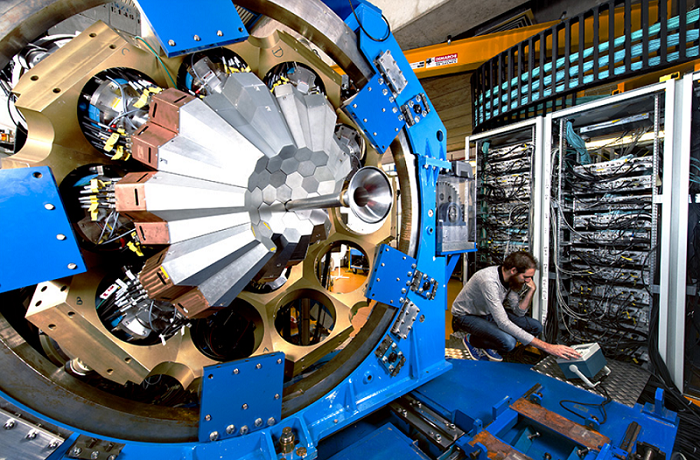Nuclear research based on strong international collaboration

In December, the Energy Platform made a digital visit to the School of Engineering Sciences’ (SCI) department of Nuclear Energy Technology, Nuclear Physics and Nuclear Power Safety - home to interdisciplinary research programmes based on strong international collaboration.
KTH's Energy Platform conducts an outreach activity of the energy-related research that is done at KTH's various Schools. In a series of visits, which have been made digitally in the past year, researchers at various colleges have given an orientation of ongoing research and development activities.
The goal is to promote collaboration between different energy researchers and projects, and contribute to the initiation of more projects in the area.
In December, Energy Platform visited the departments of Nuclear Energy Technology, Nuclear Physics and Nuclear Safety at the SCI. Lina Bertling Tjernberg, Energy Platform director, began the visits with a brief review of the platform’s goals and operations.
After that, Pavlo Kudinov, head of the Nuclear Engineering department, took over with an overview of research being conducted at the department. Here, the goal is to contribute to the development of large-scale projects and to support nuclear energy education.
Several different departments have been merged to create more opportunities for collaboration between researchers. The department has several international industrial collaborations, including with Westinghouse to which several faculty members are affiliated.
The department runs the Nuclear Energy Engineering Master’s programme, which has about 40 students a year. The course has strong ties with universities in the EU, China and South Korea, and is run in collaboration with EIT InnoEnergy’s EMINE programme.
The Nuclear Energy Technology department is set for a period of rapid growth where about 12 new doctoral students will be hired in the near future.
Pär Olsson then gave a presentation on the flagship SUNRISE project, which has received SEK 50 million of funding to 2025 from the Swedish Foundation for Strategic Research (SFF). The programme includes three schools within KTH, Luleå University of Technology and Uppsala University as well as industry representatives. The aim of the initiative is to have a demonstration fourth generation nuclear reactor ready by 2025 in order to subsequently develop a holistic concept that is economically sustainable to build and operate.
Much of the research is concentrated on the development of new materials able to withstand the extreme stresses that nuclear power technology involves. Among other things, researchers are developing new forms of steel that will be able to simultaneously withstand liquid lead and radioactive radiation. The development is described as very challenging and also involves the development of new technologies for welding, testing, reactor design, and safety.
Research is conducted in collaboration with the Materials Science department at KTH as well as with international institutions with laboratories that can handle highly radioactive substances and materials.
New methods are also being developed to analyze research results with updated theories and analytical models. Previously, models dated back to the 1960s and 70s, but today, researchers at the Nuclear Energy Technology school have contributed to modernization, among other things to predict damage, together with the Swedish Nuclear Fuel and Waste Management Company (SKB).
Professor Janne Wallenius, who provided a description of work on design and safety analysis, is also involved in the development of the fourth generation nuclear reactor. He emphasized that the reactor could contribute to research on biofuels due to the high temperature of steam that results.
This was followed by a briefing by Dmitry Grishchenko on, among other things, the MCSAFE research project, which seeks to improve safety at smaller nuclear reactors. This is a strong international research project with participants from the Czech Republic, France, Germany, the UK and elsewhere, which will be completed in 2023.
In this project, researchers at KTH Campus have developed unique equipment to study, among other things, heat transfer and high pressures.
Sean Roshan Ghias represented Nuclear Training and Safety Centre (KSU), which is a department that houses about 20 ongoing research projects, including those with strong international links.
The programme spans everything from chemistry and physics to behavioural science and social sciences. Basic research and applied research are conducted at KSU, where work is conducted on a full scale from theory to simulations and experiments.
Ghias also presented the EU’s SAFEST, (Severe Accident Facilities for European Safety Targets), project that brings together European research facilities within nuclear safety, including KTH.
The department also contributes with several courses to the Master’s programme mentioned above where students gain insights into the functioning of the reactor from a safety perspective. The department also offers an external training programme for industry.
Last out during the visit was Bo Cederwall from the department of Nuclear Physics, who presented research in medical diagnostics, (“nuclear medicine”), nuclear material control, and nuclear safety, which is conducted in collaboration with, among others, the Swedish Radiation Safety Authority, KTH Innovation, and Vinnova.
Research is conducted in experimental and applied nuclear physics by a growing group of about 20 researchers.
The more applied projects include work on various sensors and technology for measuring radiation with the development of prototypes. These can be used at airports to detect radioactive materials and to monitor international shipments of nuclear fuel or industrial waste.
Cederwall also highlighted the need for stronger collaboration in the sensor area at KTH. The programme is being conducted in parallel at several schools often using similar tools, including the development of machine learning.
During the end of the school visit, several new ideas arose for collaborative projects that could be taken further by Lina Tjernberg Bertling and Deputy Director Christophe Duwig. In the days following the visit, several researchers also submitted applications to an internal call for project proposals which was active at the time.
Text by: Magnus Trogen Pahlén.